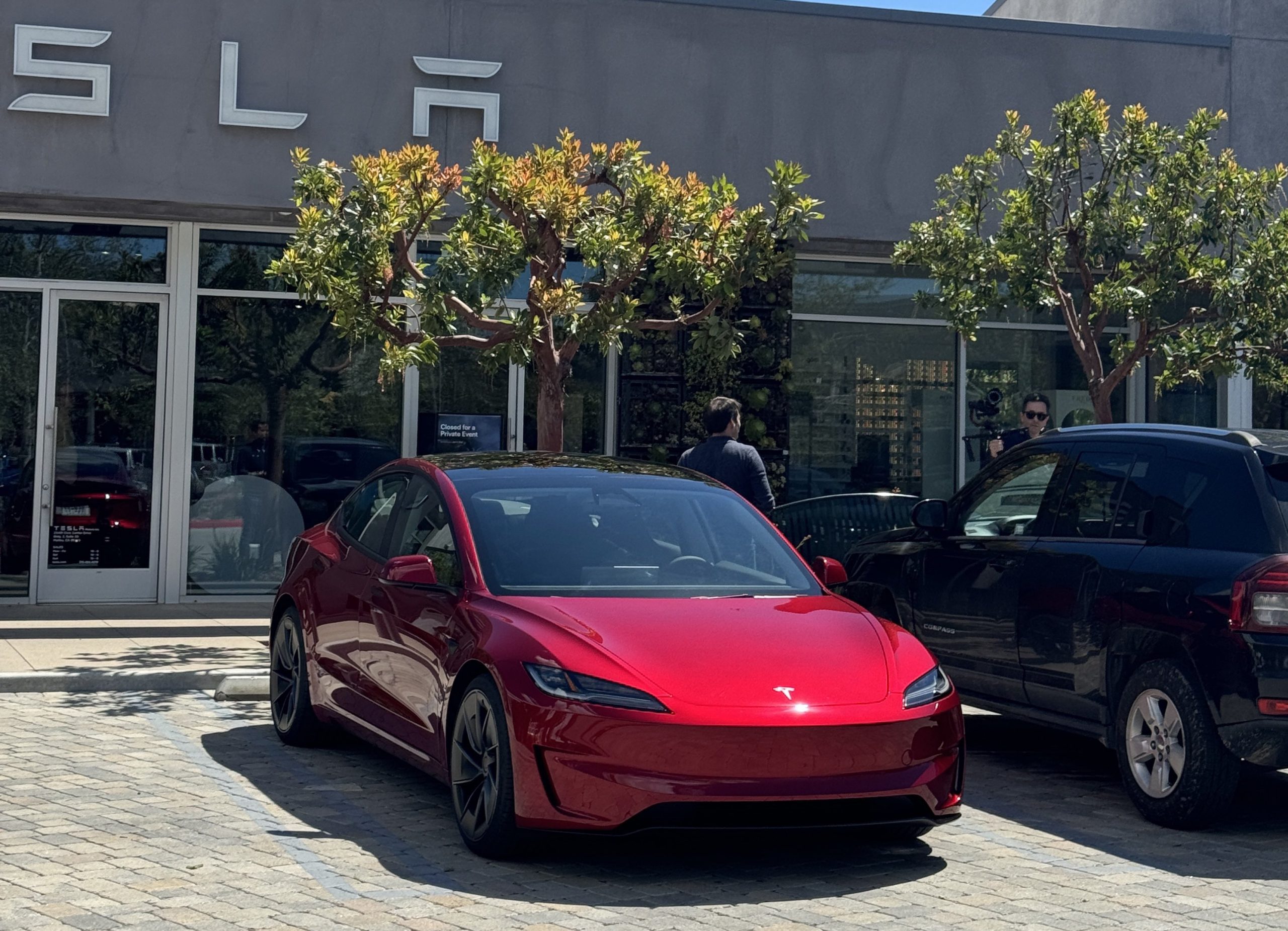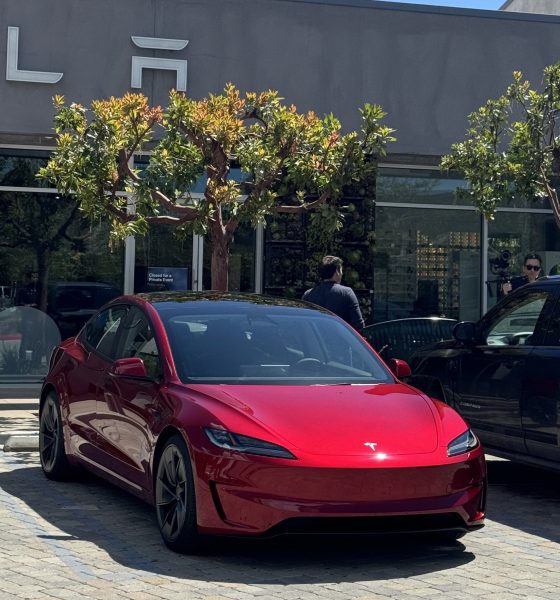Tesla has been very silent about the successor to the Model 3 Performance, arguably the electric vehicle maker’s most fun car to drive. But while Tesla’s public communication about the new Model 3 Performance is almost zero, all signs are pointing to the new vehicle being released soon.
Apart from fully-uncovered units of the new Model 3 Performance being spotted in the United States and abroad, the all-electric sedan’s order page from Great Britain was also observed to feature details about the vehicle in its source code, as noted by members of the Tesla Motors Club. While the source code did not include details like the new Model 3 Performance’s 0-60 mph time or its top speed and range, it did confirm a number of key features for the vehicle.
Following is the section about the new Model 3 Performance as observed in the source code of Great Britain’s order page for the all-electric sedan.

All-new high-performance drive units deliver more than combined 500 horsepower and 0-60 mph in (ACCELERATION) seconds. Welcome to the most powerful Model 3 ever.
Exclusive to the Model 3 Performance
The redesigned front and rear fascias, rear diffuser, and carbon fiber spoiler give a unique look and work together to optimize high-speed stability.
All-New Adaptive Suspension
All-new adaptive damping powered by in-house software gives you enhanced body control without sacrificing daily usability or comfort.

Track Mode V3
Features all-new calibration for the powertrain and adaptive suspension to give you more authority behind the wheel. Plus, you can customize handling balance, stability controls and regenerative braking to set the car up how you like it.
The latest generation driving mode integrates adaptive suspension controls with a performance-optimized powertrain to deliver more response and fun behind the wheel. Bespoke chassis and suspension hardware are tuned to provide an intuitive, razor-sharp response to driver inputs. Enhanced pedal feel and improved heat management ensure consistent braking at all speeds and across a wider temperature range.

Performance Interior
All-new seat design with enhanced side and cushion bolsters holds you in place, while ventilation keeps you cool. The lightweight carbon fiber décor and refined weave pattern are unique to Model 3 Performance.
Forged Performance Wheels
Lightweight, staggered wheels provide sharper turn-in response, improved predictability, increased traction out of corners, and optimized aerodynamics.
While the observed sections on the Model 3 Performance from the source code of the vehicle’s order page in Great Britain are very compelling, some of the information that was posted by Tesla could be placeholders. Thus, it would not be surprising if the vehicle’s official webpage proves different when it goes live. Nevertheless, the information that’s observed in the Model 3’s Great Britain order page does suggest that Tesla is ensuring that the new Model 3 Performance will be a worthy successor to its very successful and popular predecessor.
Don’t hesitate to contact us with news tips. Just send a message to simon@teslarati.com to give us a heads up.

News
Tesla China quietly posts Robotaxi-related job listing
Tesla China is currently seeking a Low Voltage Electrical Engineer to work on circuit board design for the company’s autonomous vehicles.

Tesla has posted a new job listing in Shanghai explicitly tied to its Robotaxi program, fueling speculation that the company is preparing to launch its dedicated autonomous ride-hailing service in China.
As noted in the listing, Tesla China is currently seeking a Low Voltage Electrical Engineer to work on circuit board design for the company’s autonomous vehicles.
Robotaxi-specific role
The listing, which was shared on social media platform X by industry watcher @tslaming, suggested that Tesla China is looking to fill the role urgently. The job listing itself specifically mentions that the person hired for the role will be working on the Low Voltage Hardware team, which would design the circuit boards that would serve as the nervous system of the Robotaxi.
Key tasks for the role, as indicated in the job listing, include collaboration with PCB layout, firmware, mechanical, program management, and validation teams, among other responsibilities. The role is based in Shanghai.
China Robotaxi launch
China represents a massive potential market for robotaxis, with its dense urban centers and supportive policies in select cities. Tesla has limited permission to roll out FSD in the country, though despite this, its vehicles have been hailed as among the best in the market when it comes to autonomous features. So far, at least, it appears that China supports Tesla’s FSD and Robotaxi rollout.
This was hinted at in November, when Tesla brought the Cybercab to the 8th China International Import Expo (CIIE) in Shanghai, marking the first time that the autonomous two-seater was brought to the Asia-Pacific region. The vehicle, despite not having a release date in China, received a significant amount of interest among the event’s attendees.
Elon Musk
Elon Musk and Tesla AI Director share insights after empty driver seat Robotaxi rides
The executives’ unoccupied tests hint at the rapid progress of Tesla’s unsupervised Robotaxi efforts.

Tesla CEO Elon Musk and AI Director Ashok Elluswamy celebrated Christmas Eve by sharing personal experiences with Robotaxi vehicles that had no safety monitor or occupant in the driver’s seat. Musk described the system’s “perfect driving” around Austin, while Elluswamy posted video from the back seat, calling it “an amazing experience.”
The executives’ unoccupied tests hint at the rapid progress of Tesla’s unsupervised Robotaxi efforts.
Elon and Ashok’s firsthand Robotaxi insights
Prior to Musk and the Tesla AI Director’s posts, sightings of unmanned Teslas navigating public roads were widely shared on social media. One such vehicle was spotted in Austin, Texas, which Elon Musk acknowleged by stating that “Testing is underway with no occupants in the car.”
Based on his Christmas Eve post, Musk seemed to have tested an unmanned Tesla himself. “A Tesla with no safety monitor in the car and me sitting in the passenger seat took me all around Austin on Sunday with perfect driving,” Musk wrote in his post.
Elluswamy responded with a 2-minute video showing himself in the rear of an unmanned Tesla. The video featured the vehicle’s empty front seats, as well as its smooth handling through real-world traffic. He captioned his video with the words, “It’s an amazing experience!”
Towards Unsupervised operations
During an xAI Hackathon earlier this month, Elon Musk mentioned that Tesla owed be removing Safety Monitors from its Robotaxis in Austin in just three weeks. “Unsupervised is pretty much solved at this point. So there will be Tesla Robotaxis operating in Austin with no one in them. Not even anyone in the passenger seat in about three weeks,” he said. Musk echoed similar estimates at the 2025 Annual Shareholder Meeting and the Q3 2025 earnings call.
Considering the insights that were posted Musk and Elluswamy, it does appear that Tesla is working hard towards operating its Robotaxis with no safety monitors. This is quite impressive considering that the service was launched just earlier this year.
Elon Musk
Starlink passes 9 million active customers just weeks after hitting 8 million
The milestone highlights the accelerating growth of Starlink, which has now been adding over 20,000 new users per day.

SpaceX’s Starlink satellite internet service has continued its rapid global expansion, surpassing 9 million active customers just weeks after crossing the 8 million mark.
The milestone highlights the accelerating growth of Starlink, which has now been adding over 20,000 new users per day.
9 million customers
In a post on X, SpaceX stated that Starlink now serves over 9 million active users across 155 countries, territories, and markets. The company reached 8 million customers in early November, meaning it added roughly 1 million subscribers in under seven weeks, or about 21,275 new users on average per day.
“Starlink is connecting more than 9M active customers with high-speed internet across 155 countries, territories, and many other markets,” Starlink wrote in a post on its official X account. SpaceX President Gwynne Shotwell also celebrated the milestone on X. “A huge thank you to all of our customers and congrats to the Starlink team for such an incredible product,” she wrote.
That growth rate reflects both rising demand for broadband in underserved regions and Starlink’s expanding satellite constellation, which now includes more than 9,000 low-Earth-orbit satellites designed to deliver high-speed, low-latency internet worldwide.
Starlink’s momentum
Starlink’s momentum has been building up. SpaceX reported 4.6 million Starlink customers in December 2024, followed by 7 million by August 2025, and 8 million customers in November. Independent data also suggests Starlink usage is rising sharply, with Cloudflare reporting that global web traffic from Starlink users more than doubled in 2025, as noted in an Insider report.
Starlink’s momentum is increasingly tied to SpaceX’s broader financial outlook. Elon Musk has said the satellite network is “by far” the company’s largest revenue driver, and reports suggest SpaceX may be positioning itself for an initial public offering as soon as next year, with valuations estimated as high as $1.5 trillion. Musk has also suggested in the past that Starlink could have its own IPO in the future.










